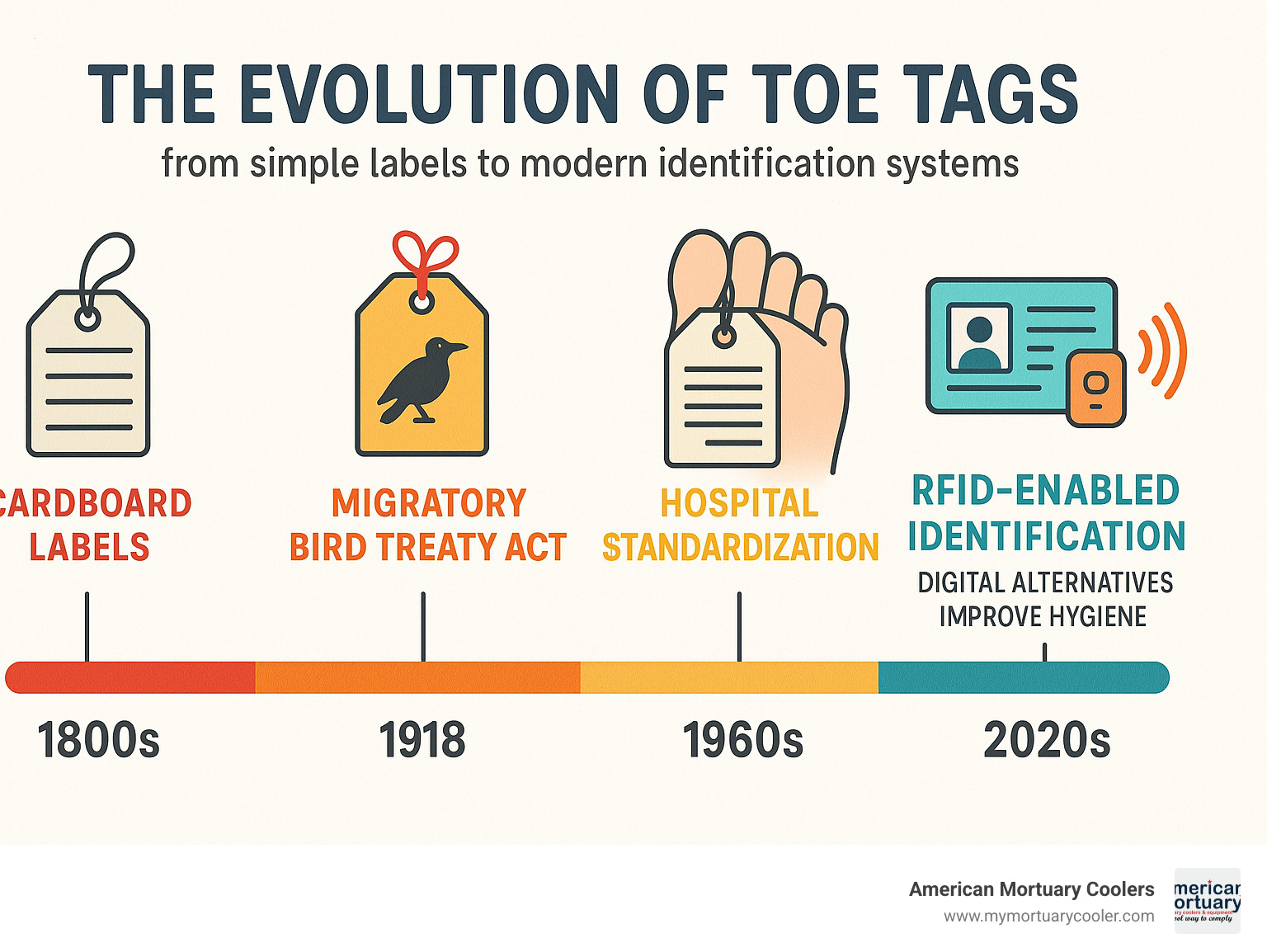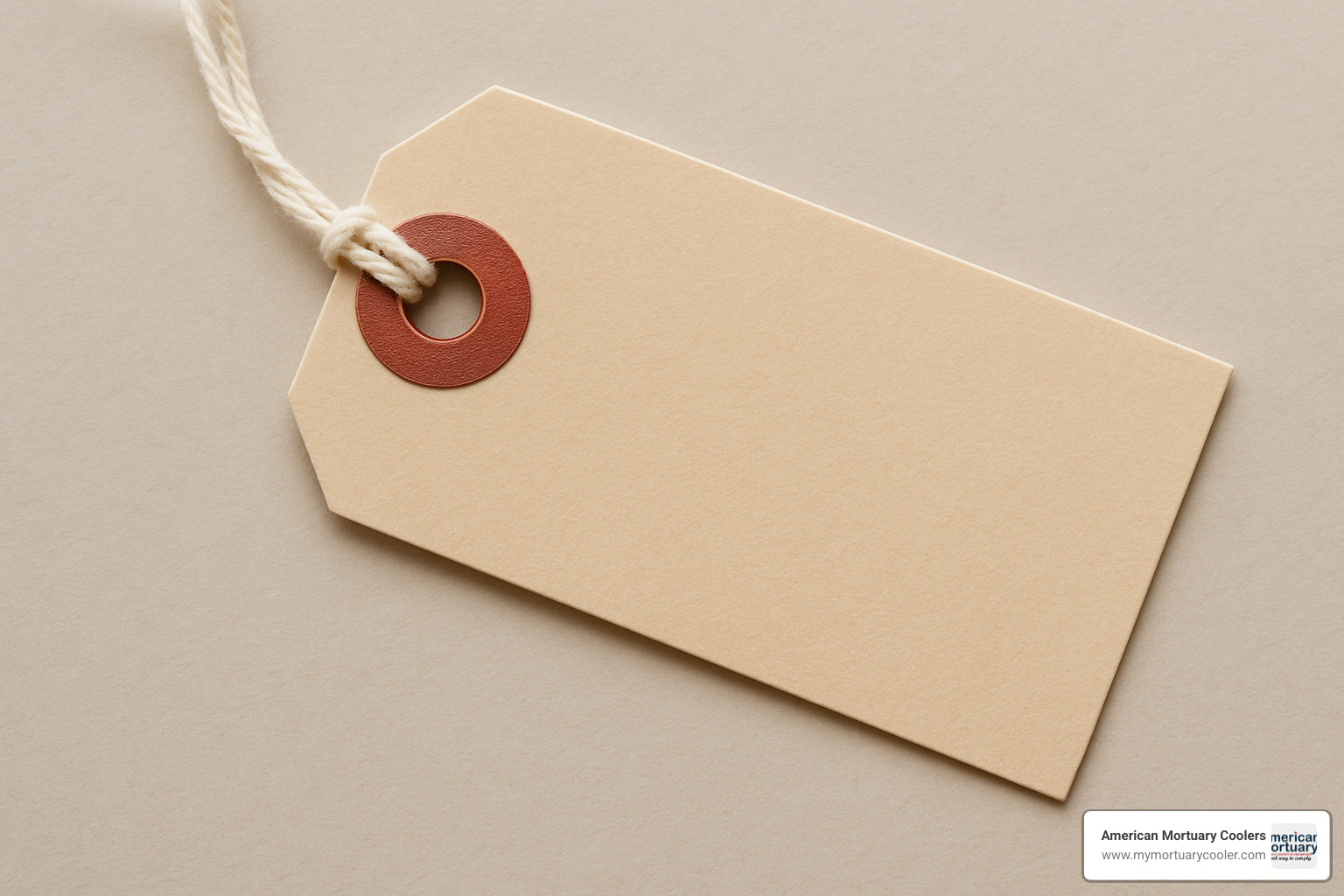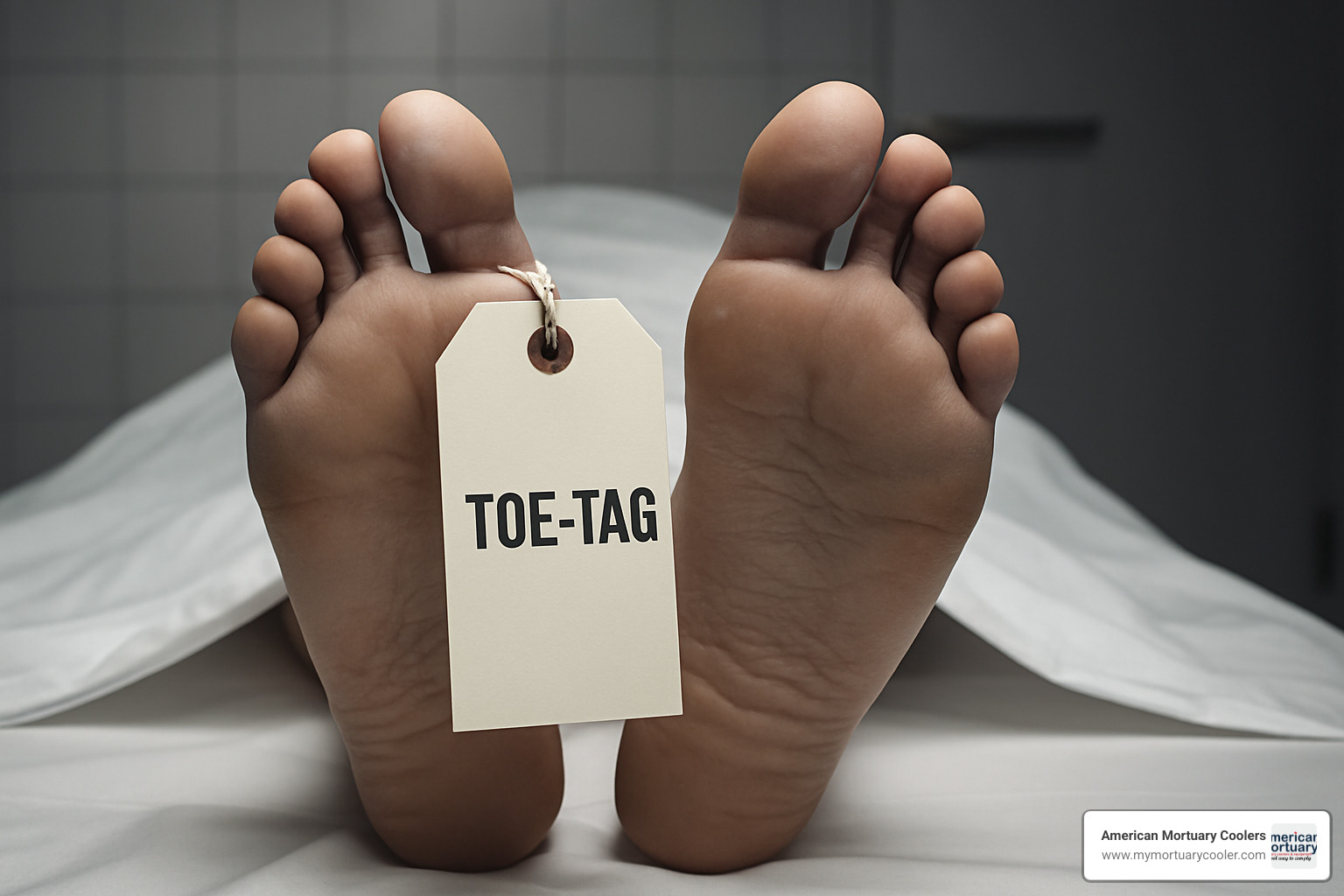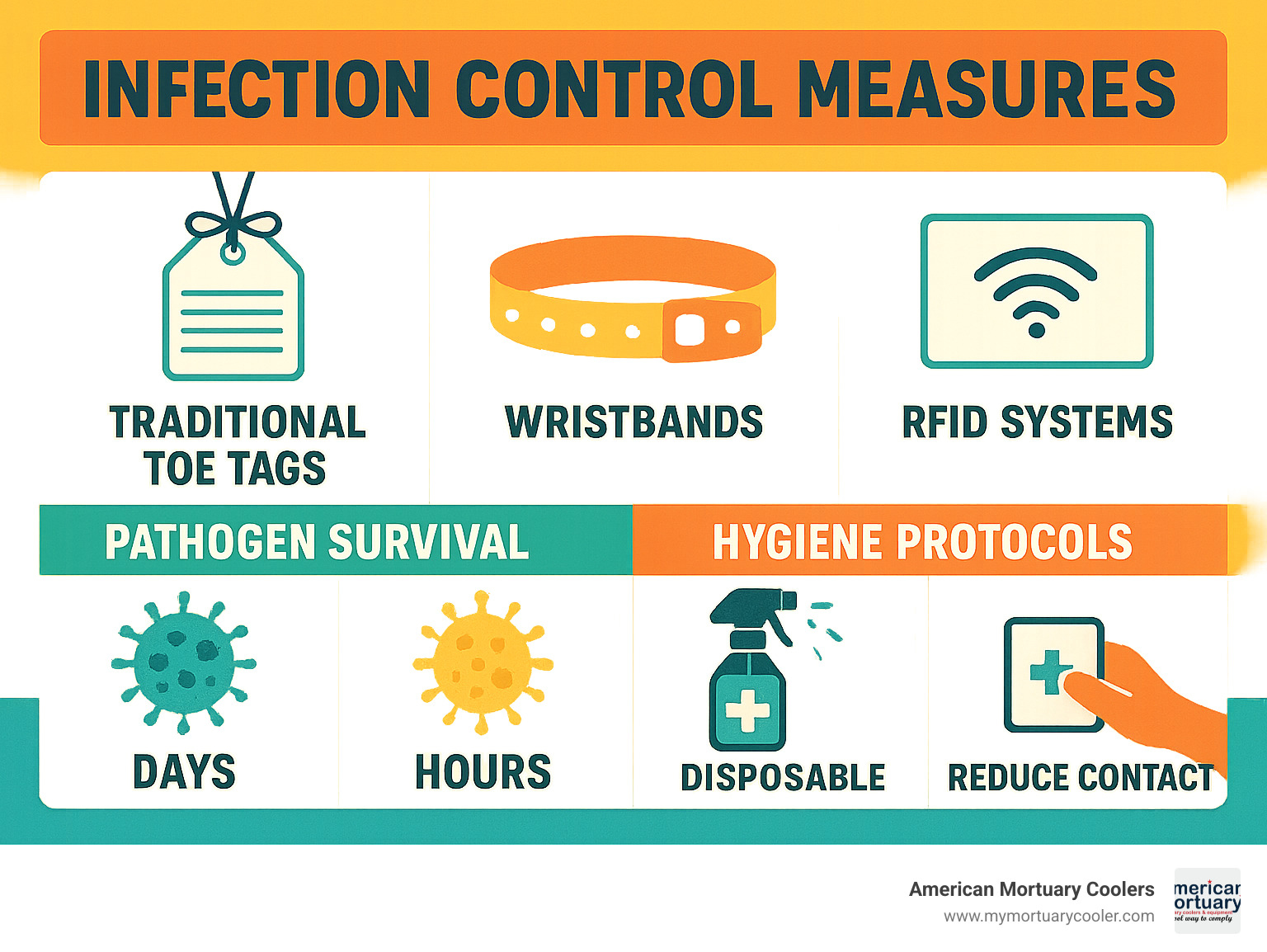Why Toe Tags Remain Essential in Modern Death Care
Toe-tags- are identification labels traditionally attached to the big toe of deceased individuals in morgues and funeral homes. While many facilities have shifted to wrist or ankle bands due to hygiene concerns, toe tags remain widely used across multiple industries - from mortuary science to waterfowl hunting compliance.
Quick Reference: Toe Tag Essentials
- Primary Use: Body identification in morgues, funeral homes, and coroner offices
- Standard Material: 13-point manila cardstock with cotton string
- Required Information: Name, case number, physical descriptors (hair/eye color)
- Legal Status: Still mandated for waterfowl hunters under Federal Migratory Game Bird Treaty Act
- Modern Alternatives: Wrist bands, ankle bands, RFID tracking systems
- Typical Packaging: Sold in bulk packs of 25, 50, or 100 tags
The humble toe tag carries surprising weight in American death care. What started as a simple cardboard rectangle has evolved into a complex identification system that must balance legal compliance, infection control, and operational efficiency.
Today's funeral directors face mounting pressure to modernize their identification protocols while maintaining the reliability that families depend on during their most difficult moments. The choice between traditional toe tags and newer alternatives isn't just about cost - it's about dignity, accuracy, and regulatory compliance.
As Mortuary Cooler with years of experience supplying funeral homes nationwide, I've seen how proper identification systems directly impact the quality of death care services. The right toe-tags- can streamline your workflow while ensuring every family receives the respectful treatment they deserve.

Easy toe-tags- glossary:
What Is a Toe Tag? History & Purpose
Picture this: it's 1880, and a busy city hospital is dealing with more bodies than they can properly identify. Someone grabs a piece of cardboard, scribbles a name on it, and ties it to a big toe with string. Simple? Yes. Effective? Absolutely. That humble moment gave birth to what we now know as the toe tag.
The story of toe-tags- really begins in those chaotic 19th-century hospitals. As cities grew larger and public health crises hit harder, hospitals desperately needed a reliable way to keep track of the deceased. The big toe became the perfect spot - it was easy to reach, stayed put during transport, and didn't get in the way when doctors needed to work.
What started as basic cardboard has come a long way. Today's toe-tags- are typically made from 13-point manila cardstock - much tougher than those early paper scraps. Some facilities have gone high-tech with waterproof synthetic materials or even RFID chips that can track a body's location in real-time.
But here's the interesting twist: many morgues are actually moving away from traditional toe tags. Wrist and ankle bands have become increasingly popular because they're more hygienic and easier for staff to access when wearing gloves and protective gear. Still, toe tags haven't disappeared - they're just finding new homes in different industries.
The shift makes sense when you think about it. Modern death care is all about balancing respect for families, staff safety, and accurate record-keeping. Sometimes that means updating century-old practices, even when they've worked well for generations.
From Battlefield to Modern Morgue
The idea of tagging human remains actually started on battlefields, not in hospitals. Civil War soldiers wore early versions of "dog tags" so their bodies could be identified if they fell in combat. Those metal tags were built to survive weather, blood, and chaos - setting the standard for durability that we still follow today.
When the 1918 influenza pandemic swept across the world, killing around 50 million people, hospitals found themselves completely overwhelmed. Morgues were packed beyond capacity, and keeping track of bodies became a nightmare. That crisis proved just how critical proper identification systems really were.
By the 1950s, standardized morgue protocols had emerged across America. The toe tag became the official way to identify bodies, with strict rules about what information to include, how to attach them, and who could handle them. This wasn't just paperwork - families depended on these systems to find their loved ones, and courts relied on them for legal proceedings.
These standardized protocols created the foundation for modern death care. Every funeral director, coroner, and medical examiner knew exactly what a toe tag should look like and how to use it properly. That consistency helped build trust in a system that families turn to during their most difficult moments.
Toe-tags- Anatomy, Materials & Legal Requirements

When you're looking at a toe tag for the first time, it might seem like just a simple piece of cardboard with a string. But there's actually a lot more engineering and legal consideration that goes into these humble identification tools than you might expect.
The standard mortuary toe tag measures about 3-3/4" by 1-7/8" - just the right size to hold essential information without being bulky or getting in the way during handling. For special situations, you can find larger formats up to 6-1/4" by 3-1/8" when you need extra space for detailed information.
Most professional toe-tags- are made from 13-point manila cardstock. This might sound fancy, but it's really just thick, durable paper that won't fall apart when it gets wet or handled frequently. It's also designed to work well with different pens and markers without the ink bleeding or smudging.
For outdoor applications like hunting, waterproof synthetic materials have become increasingly popular. These plastic-based tags cost more than cardboard, but they'll survive a downpour and still be perfectly readable. They're also tear-resistant, which is crucial when you're dealing with field conditions.
The legal side of toe tags gets complicated fast. In medical settings, you're dealing with state coroner regulations and federal guidelines that specify exactly what information must be included and how it needs to be displayed. For waterfowl hunting, the Migratory Bird Treaty Act sets strict federal requirements that can result in hefty fines if you don't follow them properly.
Standard Anatomy of a Toe Tag
Every well-made toe tag starts with a perforated hole that's been reinforced to prevent tearing. This might seem like a small detail, but when you're dealing with the weight of a body during transport, that little reinforcement can make the difference between a tag that stays attached and one that gets lost.
The cotton string attachment is still the gold standard in the industry. Cotton is biodegradable, strong enough for the job, and easy to tie securely. Pre-strung tags have become the norm because they save precious time in high-stress situations. When you're working in a busy morgue or coroner's office, those few seconds saved per tag really add up.
Some modern facilities are moving toward barcode or RFID chip integration for electronic tracking. These high-tech options help reduce human error and speed up record-keeping, but they come with a much higher price tag and require special scanning equipment. Most smaller facilities stick with traditional tags for cost reasons.
The duplicate stub system is a clever solution for maintaining records. Part of the tag stays with your paperwork while the main section travels with the body. This creates a paper trail that's essential for legal compliance and helps prevent mix-ups that could devastate families.
Legal Standards for toe-tags- in Medical Settings
The legal requirements for toe-tags- in medical settings can feel overwhelming, but they exist for good reason. State coroner regulations vary significantly from place to place, but they all focus on preventing the kind of identification errors that can destroy families and end careers.
The Joint Commission sets standards for healthcare organizations that extend to how deceased patients are identified. Their guidelines emphasize accuracy, legibility, and verification procedures - basically making sure the right information is clearly written and double-checked by qualified staff.
Chain-of-custody requirements mean you need to document every time a toe tag is applied, modified, or removed. This paperwork might seem tedious, but it becomes crucial evidence if there's ever a legal challenge or investigation. The documentation proves that proper procedures were followed throughout the entire process.
HIPAA regulations add another layer of complexity because they require protecting patient privacy even after death. Some facilities use coded systems or cover sensitive information to comply with privacy rules while still maintaining accurate identification. It's a delicate balance between transparency and confidentiality.
For more detailed information about how these regulations apply in different settings, check out our Complete Guide to Morgue vs Mortuary: Key Differences Explained.
toe-tags- for Waterfowl Hunting Compliance

Here's where toe-tags- take an interesting turn away from morgues and into the great outdoors. The Federal Migratory Game Bird Treaty Act of 1918 requires hunters to tag every waterfowl and game bird they harvest. Miss this step, and you're looking at serious federal fines and potentially losing your hunting privileges.
Hunting toe tags need to include the hunter's name, license number, bird species, harvest date, and location. The tag must stay attached to the bird during transport and storage until you're ready to process or consume it. Game wardens take this seriously, and they have the authority to check your tags at any time.
Waterproof and smudge-resistant materials are non-negotiable for hunting applications. Your tag needs to stay readable whether you're hunting in a downpour or dealing with wet birds and muddy conditions. Many hunting-specific tags feature reinforced attachment points that can handle the rough treatment that comes with field dressing and transport.
Different bird species require different tag sizes. Small birds like teal work fine with the standard 3-3/4" by 1-7/8" tags, but large geese need the bigger 6-1/4" by 3-1/8" format to accommodate all the required information. Carrier tag systems let successful hunters group multiple birds under one tag, which simplifies compliance when you've had a particularly good day in the field.
Specialized hunting toe tags that meet federal requirements are available through various sporting goods retailers and online suppliers who focus on regulation-compliant tagging solutions designed specifically for waterfowl hunters.
Applications Across Industries & Culture
When most people think of toe-tags-, they picture morgues and funeral homes. Yet the same durable tag shows up in crime labs, evidence rooms, airlines, and even commuter-bike programs because it simply works: it stays attached and stays legible.
In crime laboratories, toe-tag derivatives double as evidence markers that travel from scene to courtroom. Many now include barcodes or RFID chips, but the paper-and-string concept remains unchanged.
Pop culture has turned the tag into shorthand for mystery and forensic investigation, spawning novelty versions for Halloween or escape-room props. The design’s instant recognizability keeps it popular far beyond the death-care world.
Inside the Morgue Workflow
The process is straightforward: staff record key information, attach the tag, and move the body to refrigerated storage. In coolers, condensation ruins adhesive labels and extreme cold slows electronics, but cardstock on cotton string performs reliably. During autopsy, pathologists can confirm identity at a glance without booting a computer—a critical safeguard when seconds count.
For a deeper dive into morgue operations, see Toe Tags, Autopsies & Morgue Coolers: A Guide by American Mortuary Coolers Equipment.
Beyond Death Care
Airlines borrow the idea for baggage tags, Caltrain uses it to sort commuter bicycles, and hunters rely on waterproof versions to satisfy federal wildlife laws. Collectors and educators seek vintage tags for historical displays, proving a simple design can span countless niches.
Safety, Sustainability & Alternatives

COVID-19 forced funeral homes to re-evaluate every surface that staff touch—including tags. Although SARS-CoV-2 can persist on cardboard for up to 24 hours, the single-use nature of toe tags and strict glove changes keep risk low. Many operations now pair traditional tags with touch-free barcode or RFID tracking for extra redundancy.
Hygiene Best Practices
- Wear new gloves for every decedent.
- Place used tags straight into medical-waste containers—never regular trash.
- Do not reuse tags; microscopic fibers can hide pathogens even after disinfection.
Green & Ethical Considerations
Toe tags made from FSC-certified paper and biodegradable cotton decompose naturally, offering an eco-friendly alternative to plastic wristbands. Facilities needing greater durability can choose reusable silicone bands, provided they have robust cleaning protocols.
| Feature | Traditional Toe Tag | Wristband | RFID System |
|---|---|---|---|
| Cost per unit | $0.10–0.25 | $0.15–0.35 | $2–5 |
| Infection control | Disposable | Disposable | Reusable |
| Durability | Good | Excellent | Excellent |
| Weather resistance | Fair | Good | Excellent |
| Tech required | None | None | Scanner |
Buying Guide, FAQs & Next Steps
Picking the right toe-tags- comes down to quantity, environment, and compliance requirements. Bulk packs of 25, 50, or 100 give the best price break; 13-point manila with pre-attached cotton string remains the affordable standby for morgues, while hunters may prefer waterproof synthetics. Custom printing can add logos or barcodes that speed paperwork, though it raises unit cost.
Choosing the Right Tag
- Pre-strung: quickest to deploy, slightly higher cost
- Blank: cheaper, but someone must attach string
- Morgue grade: fine for controlled indoor use
- Hunting grade: waterproof, tear-resistant for field conditions
FAQ 1 – Are toe tags still legal everywhere?
Yes. Hospitals follow state rules; hunters follow federal wildlife laws. Facilities may prefer wristbands for hygiene but still keep toe tags as a backup.
FAQ 2 – What info MUST be on a toe tag?
Full name, case or license number, date, and enough physical descriptors to verify identity. Hunters must also list species and harvest location.
FAQ 3 – Where can I buy authentic tags?
Most medical-supply distributors and online retailers stock compliant tags and offer customization.
Call to Action
American Mortuary Coolers ships custom mortuary coolers and identification supplies to every state in the contiguous U.S. Explore solutions or request a quote at mymortuarycooler.com.



















